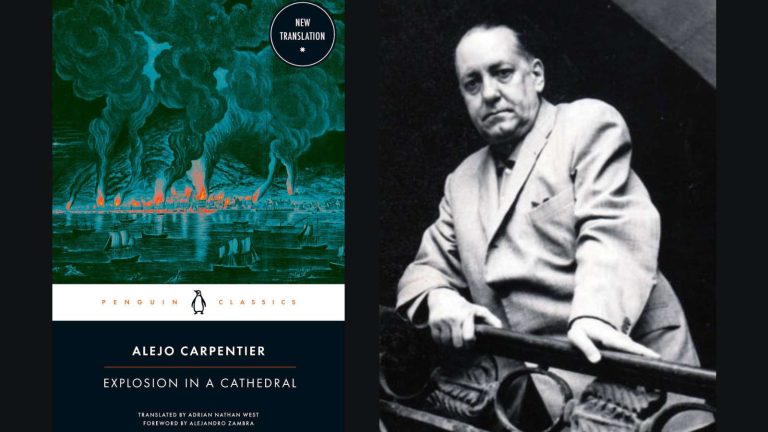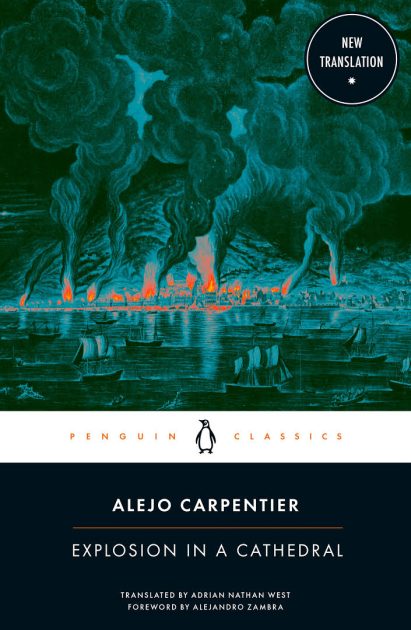
Alejo Carpentier’s Critical Cathedral
19 January, 2024A new translation of one of Latin America’s greatest novels
Flying from Caracas to Paris in the 1950s to accept a literary prize, Alejo Carpentier’s plane experienced mechanical problems and was grounded for several days on the island of Guadeloupe. There, he discovered the obscure historical figure of Victor Hugues, the French merchant who reclaimed Guadeloupe for Revolutionary France in 1794 and unleashed the guillotine on enemies and opposition, earning the legacy “Robespierre of the Caribbean.” Fascinated by this character, Carpentier scribbled the plot of a new historical fiction, later to become Explosion in a Cathedral, on a restaurant menu before leaving the island.
The novel has long been considered the Cuban writer’s most impressive work. Two years after its publication in 1962, critics were calling for a Nobel Prize for him and many already considered Carpentier one of the greatest novelists of the twentieth century. Thanks to a new superb translation by Adrian Nathan West—the Gregory Rabassa of our day—a long overdue spotlight has been redirected on Carpentier’s literary significance and what Explosion in a Cathedral still has to say about the validity of revolutions and the perils of political corruption.
Against the twilight of the eighteenth century, Victor Hugues and the fictional protagonist Esteban—a young bourgeois from Havana—cast off from the shores of metropolitan France to export the Revolution, and Jacobean politics, to the Caribbean. “This, too has come with us, then?” Esteban exclaims as sailors unpack the blade of the guillotine. “This and the printing press are the most important cargo we have, apart from the cannons,” Victor responds, unveiling his strategy to disseminate Liberty by eliminating opposition, spreading propaganda, and instilling violence. “But do you know what else I’m bringing to the new world?” Victor added. “The Decree of 16 Pluviôse of Year II, which declares slavery abolished.”
But with the French tricolour flag raised above Guadeloupe, Victor as Commissar arrested and guillotined several freed slaves for refusing to work the expropriated fields. He ordered the captains of French privateer ships not to engage in the slave trade but permitted them to acquire slaves from English or Spanish ships and sell them in Dutch ports. And when news from Paris announced the reinstitution of religion, Victor delayed the decree on Guadeloupe under the pretext that “They haven’t even demolished the church on the Morne du Gouvernement. Now would be too soon … We are not in the same latitudes here as the Champs de Mars.”
Baffled by Victor’s flagrant corruption, Esteban’s eyes—once veiled by the utopian ideals of Rousseau and Voltaire—gradually open to the contradictory and barbaric nature of the French Revolution. “Contradictions and more contradictions,” Esteban lamented, “The revolution I dreamed of was nothing like this.” When he finally returns home to Havana, he confesses: “I am back from life among barbarians.”
The novel has long been viewed as a commentary on the tragic paradox of the French Revolution and the fickleness of the Enlightenment. “If one takes a look around this famous Age of Enlightenment,” recalled Carpentier, “it was an awful Age… On the one hand, enlightenment did in fact arrive for the philosophers, for the French encyclopedists; on the other, it remained dark for millions in the colonies, massacred and enslaved.”
A new translation of this political critique, in mass market form published by Penguin Classics, could not come at a better time. The themes of corruption, power abuse, and discrimination seem just as relevant now as they did for the culprits of revolutions two hundred years ago. Just as Montesquieu warned, half a century before the French Revolution, that “every man invested with power is apt to abuse it, and to carry his authority as far as it will go,” so too does Carpentier issue a warning through the character transformations of Victor and Esteban: Reason and power, in the wrong hands, can be bent beyond the common good of society and stretched to its most extreme and fanatical limits.
Carpentier’s literary enterprise endlessly searched for the syncretic origins of American consciousness—what he termed the “Americanness” of Latin America—which he expressed through the literary ploys of lo real maravilloso (“marvellous reality,” later known as magical realism), and the “baroque.” The ingenuity of his later fictions—namely The Kingdom of this World (1949), The Lost Steps (1953), and Explosion in a Cathedral (1962)—helped establish the foundation for an autonomous modern tradition that would carry Latin American literature into the internationally acclaimed “boom” era of the late sixties and seventies.
For Carpentier, “marvellous reality” was an everyday occurrence of contradictions and absurdities that eternally haunt Latin American history and the present. Absurdities in Explosion in a Cathedral such as the slave ship owned by a philosopher friend of Rousseau called The Social Contract that plied the Caribbean waters; or the nine slaves, convicted of sedition, sentenced to have their left legs amputated “cleanly, in accordance with scientific techniques, avoiding those archaic procedures of more barbaric eras that caused excessive suffering or endangered the lives of the condemned.”
Carpentier’s absurd realities are made all the more fantastic by his signature baroque language. Often archaic, verbose, and flamboyant, Carpentier’s lexical density and verbal ornament can be likened to the overly embellished façade of an eighteenth-century cathedral. Take, for example, when Esteban reflects on his home in Havana:
There was more coal than flames in that painting of a Tropic which from here appeared static, oppressive, and monotonous, with its endlessly reiterated paroxysm of colour and its nights falling from the sky so one hurried to fetch the lamps—long nights stretched longer by the silence of people who drifted into sleep before the voice of the sentry chanted the hour, ten o’clock, in the name of most blessed Mary, conceived without sin, pray for us who have recourse in thee…
“Carpentier can go overboard at times,” West commented when asked about translating such wordiness, “but there’s no doubt that at his best, he’s impressive.”
It’s no surprise then that the generation of celebrity novelists who ushered in the Latin American literary “boom” were directly influenced by Carpentier’s work. Carlos Fuentes wrote his most acclaimed novel The Death of Artemio Cruz (1962) under Carpentier’s influence in Cuba, and the Nobel Prize-winning Gabriel García Márquez, after reading Explosion in a Cathedral, scrapped the initial draft of his magical realism and baroque masterpiece One Hundred Years of Solitude (1967) and started over again.

Follow Sounds and Colours: Facebook / Twitter / Instagram / Mixcloud / Soundcloud / Bandcamp
Subscribe to the Sounds and Colours Newsletter for regular updates, news and competitions bringing the best of Latin American culture direct to your Inbox.

